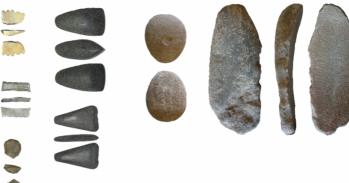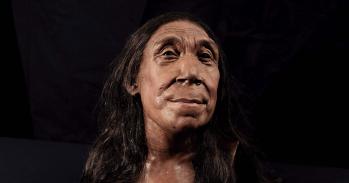
The traditional image of Neanderthals as gritty people who spent most of their time out hunting might not be entirely accurate, according to a new study revealing that they may have had to devote hours to daily subsistence tasks instead.
The traditional image of Neanderthals as gritty people who spent most of their time out hunting might not be entirely accurate, according to a new study revealing that they may have had to devote hours to daily subsistence tasks instead.
If we are right, this changes our picture of the daily activities of Neanderthals.
Colin Shaw
Our extinct prehistoric cousins, the Neanderthals, may have spent less of their time living the rugged life of the hunter and more of it carrying out tedious domestic chores, a new study suggests.
Researchers investigated the causes of distinctive skeletal features that occur in Neanderthal remains. Compared with modern and most prehistoric Homo sapiens, Neanderthal skeletons have significantly overdeveloped right arms. In some cases, their upper arm bones are as much as 50% stronger on their right side than their left. By comparison, living humans display much lower levels of upper arm bone strength asymmetry at about 5-15%.
Biological anthropologists have previously argued that this was the result of right-handed Neanderthals using spears to hunt big game, which would have certainly been an activity critical to ensuring their survival in the variable climate of the Pleistocene epoch, from about 450,000 to 30,000 years ago.
The new study suggests that Neanderthal skeletal asymmetry may have been the result of a less glamorous subsistence task. The paper, published in the journal PLOS One suggests that Neanderthals may have spent hours scraping animal hides using stone tools possibly for clothing production. That would have been an arduous and repetitive task, essential in the cold conditions in which they lived.
“The asymmetry we see in the arms of Neanderthals is far more profound than anything we encounter in modern humans except some sportspeople, such as cricketers and tennis players”, Dr Colin Shaw, from the PAVE research group and the McDonald Institute for Archaeological Research at the University of Cambridge, said.
“The skeletal remains suggest that Neanderthals were doing something intense or repetitive, or both, that had a significant role in their lives. If it was hunting, it was taking up a great deal of their time. Not surprisingly, that theory has coloured our view of Neanderthal ‘the hunter’.”
“Our research moves away from that perspective. Hunting was an important part of the lives of Neanderthals. However, for much of their time Neanderthals might have been performing other tasks, such as preparing skins. If we are right, it changes our picture of the daily activities of Neanderthals.”
The notion that the Neanderthal’s skeletal asymmetry might be the result of hunting became popular in the mid-1990s. The bones in question are the wrong cross-sectional shape to have developed as the result of repeatedly throwing spears, like a javelin. Experts have suggested, however, that they may have used spears two-handed and in an underarm motion, like a pool cue. Despite other convincing research, there had not been any tests of the musculature to examine this thesis, until now.
The new study was carried out by a team of researchers from the Universities of Cambridge, Oxford and Penn State in the US. To measure the impact of repeated hide-scraping, and of a spear being used two-handed to kill game at close-quarters, the researchers carried out several tests in which groups of right-handed men were asked to carry out tasks replicating both activities.
The impact on the upper arm was tested using a technique called electromyography, in which the electrical potential generated by muscles is measured during activity. The muscles analysed in this case were those at the shoulder and chest, which act as the primary movers of the humerus. Assessing their activity would provide a good indication of loads imposed upon the humerus (upper arm bone).
Surprisingly, they found that during two-handed spear thrusting tasks, the muscular activity was far higher in the left arm compared to the right. “It appears that because the left hand is the closest point of contact when the spear impacts the target,” said Shaw, “the reaction force is primarily countered by aspects of the musculoskeletal system on the left side of the body.”
By contrast, one-handed scraping tasks that simulated the processing of animal hides to be used as clothing required far more muscular activity on the right side of the body in precisely those areas which would lead to over-development of the upper-right arm. This suggests something other than hunting, and quite possibly the scraping of animal skins, was a task which occupied large amounts of the Neanderthals’ time, and influenced the unique morphology of their upper body.
The idea that scraping animal hides was indeed a popular activity seems likely because Neanderthals would have required protective and warm clothing. One of the tools most commonly found with Neanderthal skeletal remains is the racloir, or ‘side-scraper’, a device used to scrape soft tissue from the underside of animal hides.
Although we have no way of knowing for sure how the Neanderthals made clothes, an educated guess can be made on the basis of ethnographic studies of traditional communities in places such as Ethiopia, British Columbia and Alaska, where animal hides are still prepared.
These studies have shown that processing animal skins is quite a laborious task, and even experienced individuals need about eight hours to scrape a single hide. Preparing several hides for each member of a community would have required exactly the sort of repetitious activity attested to by the overdeveloped right arms of Neanderthal skeletons.
The researchers behind the new study admit that it can only go so far to explain the skeletal asymmetry. In ethnographic studies, for example, women rather than men are those who primarily prepare the animal hides. Insufficient numbers of female Neanderthal remains have been identified for a comparative study to be possible.
There is also the possibility that more Neanderthals than we think were left-handed. This seems unlikely, however. “We should always be tentative when making judgments about prehistory because any conclusions we draw are really inferences,” Shaw said. “About 90% of modern humans, however, are right-handed and that has been a dominant trend for at least 10,000 years. There is no obvious reason to suppose that Neanderthals were different.”
This work is licensed under a Creative Commons Licence. If you use this content on your site please link back to this page.





